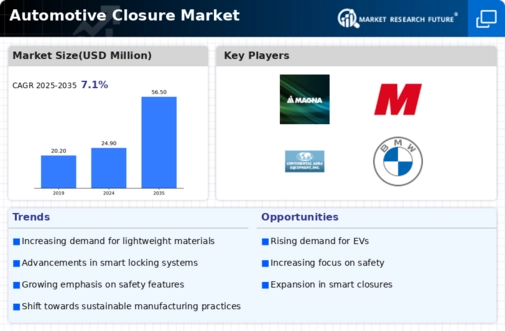Market Share
Automotive Closure Market Share Analysis
The automotive closure market, encompassing doors, hoods, trunks, and other vehicle closures, has been experiencing notable shifts driven by several key trends in recent times. One prominent trend shaping this market is the increasing integration of advanced technologies in automotive closures. Manufacturers are focusing on incorporating smart and automated features into closure systems, such as power-operated doors and hands-free trunk opening mechanisms. These technologies enhance convenience for vehicle owners while aligning with the growing demand for seamless and user-friendly automotive experiences.
Furthermore, there's a notable emphasis on lightweight materials and design optimization in automotive closures. As the automotive industry strives for improved fuel efficiency and reduced emissions, manufacturers are investing in lightweight materials like aluminum, composite plastics, and high-strength steel to construct closures. This trend aims to decrease the overall vehicle weight, contributing to fuel savings without compromising on safety or functionality. Additionally, design optimization techniques are being employed to create closures that not only enhance aerodynamics but also improve vehicle aesthetics and performance.
Moreover, the rise of electric and autonomous vehicles is significantly impacting the automotive closure market. Electric vehicles (EVs) and autonomous vehicles (AVs) require specialized closure systems to accommodate their unique designs and functionalities. The demand for closures that integrate seamlessly with electric vehicle architectures, providing efficient sealing and insulation to maintain battery performance and range, is on the rise. Similarly, closures in autonomous vehicles are undergoing transformations to accommodate new sensor placements, ensuring unobstructed functionality while prioritizing safety and reliability.
Additionally, there is a growing trend towards enhanced safety and security features in automotive closures. Manufacturers are incorporating advanced locking mechanisms, anti-pinch technologies, and sensor-based systems to improve safety for vehicle occupants and prevent theft. These features not only enhance the overall security of the vehicle but also contribute to consumer confidence and satisfaction.
Furthermore, the push towards sustainability and eco-friendly solutions is influencing the automotive closure market. Manufacturers are exploring recyclable materials and eco-conscious production processes to reduce environmental impact. Additionally, the focus on end-of-life vehicle recycling drives the development of closures that are easier to disassemble and recycle, aligning with circular economy principles.
The evolution of vehicle connectivity and the advent of smart car ecosystems are also influencing automotive closures. With the integration of connectivity features, closures are becoming part of a broader network within the vehicle, enabling functionalities such as remote locking/unlocking, notifications, and integration with mobile applications. These smart capabilities enhance convenience and security for vehicle owners, reflecting the market's response to the growing demand for connected and digitally integrated automotive systems.
The automotive closure market is undergoing a transformation spurred by technological advancements, lightweight materials, EV and AV trends, safety enhancements, sustainability initiatives, and connectivity requirements. The convergence of these trends is reshaping closure systems, leading to more sophisticated, efficient, and secure solutions. As automakers continue to innovate and adapt to evolving consumer preferences, regulatory standards, and technological advancements, the automotive closure market is poised for further developments and growth in the foreseeable future.







Leave a Comment